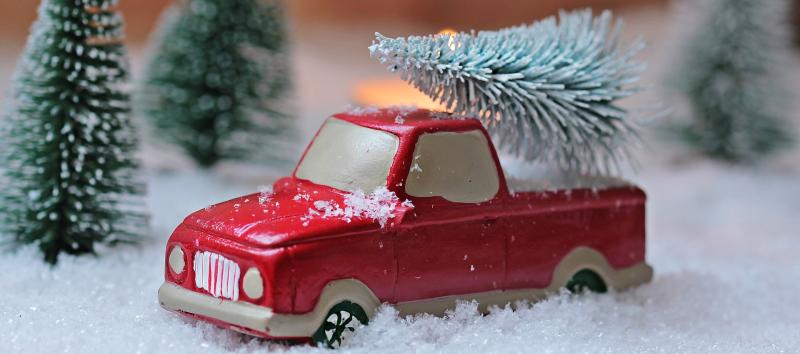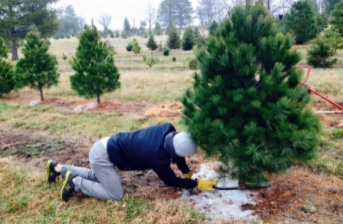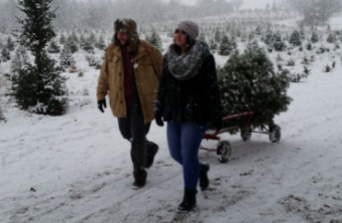
Nebraska has more than 20 tree farms in central and eastern Nebraska that grow and sell Christmas trees. A variety of tree species are available, including Scotch, Austrian, Red and White pine; Colorado blue and Norway spruce; and Balsam, Concolor, Cannan, Fraser and Douglas fir, so you can find your ideal holiday tree.
Choosing a locally grown tree provides the freshest possible tree for your home and helps support the local economy. Depending on the tree farm you visit, you may be able to cut down the perfect tree yourself, or farm staff may do it for you while you enjoy a cup of hot cider. A listing of Nebraska tree farms is available on the Nebraska Department of Agriculture's website, Christmas Tree Grower Web Directory. It includes a list of tree species available at each farm, their days and hours of operation, and any special activities or services available.
If you don't want to visit a tree farm, try to find a tree lot that sells Nebraska-grown Christmas trees.
When picking out a tree, follow these guidelines to choose the freshest tree possible.
- To evaluate a tree’s freshness before purchase, gently stroke or pull the needles. If green needles drop off or pull off in your hand, the tree is not fresh.
- Another test is to lift the tree and strike the butt on the ground. If brown needles fall from the inner portion of the tree, these are needles that were shed by the tree naturally and are not a problem. If green needles fall from the outer portion of the tree, then the tree is not fresh.
- Check to see that the tree has a fresh, green color. Some trees are sprayed with a blue-green dye. This dye is harmless, but be sure it's not hiding a dry tree.
- Break a few needles. They should be flexible and will feel moist or possibly sticky. They should also be fragrant when crushed.
- Ask the dealer if the tree was locally grown. Local trees are much more likely to be fresh because they are cut nearer Christmas and aren't shipped long distances.
 Christmas Tree Care
Christmas Tree Care
After selecting a Christmas tree, store the tree in a dark corner of your garage, away from sunlight if you don't plan to set it up right away. Cool temperatures slow the rate of water lost through the needles from the tree. Make a fresh cut to the base of the trunk by sawing off about an inch or two at the trunk's base, creating a nice, flat surface so the tree sits well in its stand. This cut removes several layers of cells at the cut surface that are filled with clotted resin and prevent the tree from absorbing water.
Place the tree trunk in a pail of water until you bring it inside to decorate, and don't let the pail go dry. Your tree is still alive, even though it has been cut from its root system; it needs water to prevent the needles from drying and the boughs from drooping. Before bringing the tree indoors, make another fresh cut to the base of the trunk to ensure that your tree has the best water up-take ability while it is in your home.
When choosing a location for the tree, use common sense safety precautions by keeping it away from heat sources such as fireplaces, TV's, radiators, and air ducts, and never have open flames on or near a Christmas tree.
 When you bring the tree inside, keep the base of the trunk in water. A Christmas tree may absorb a gallon or more of water daily depending on its size and condition. Providing plenty of water will keep the tree fresh and maintain the aroma throughout the season. Fresh cut trees, if cared for properly, can last four or five weeks indoors.
When you bring the tree inside, keep the base of the trunk in water. A Christmas tree may absorb a gallon or more of water daily depending on its size and condition. Providing plenty of water will keep the tree fresh and maintain the aroma throughout the season. Fresh cut trees, if cared for properly, can last four or five weeks indoors.
Myths abound about additives to the water to keep your tree fresh, but research has found that plain water is best. Commercial preservative mixes, aspirin, sugar, and other common home remedies don't provide any benefits.
If you accidentally let the tree stand dry out during the hustle and bustle of the holiday season, realize that this will shorten the life of your tree. Once the water is gone, the water-absorbing cells become plugged with resin very quickly and the tree's ability to uptake water is greatly reduced. The only way to fix the problem is to make another fresh cut to the base of the trunk, so make it a habit to check the tree stand each day.
Christmas Tree Fun Facts
- Christmas trees were introduced in the United States, as part of holiday celebrations, by German settlers in the 1800s. They quickly went from small tabletop trees to large floor-to-ceiling trees.
- The first Christmas tree farm was planted in 1901 by W.V. McGalliard, in response to the growing concern of over harvesting natural evergreen tree stands.
- There are close to 15,000 Christmas tree farms, encompassing approximately 350,000 acres, in the United States and over 100,000 people employed either full or part time in the industry.
- The top Christmas tree producing states are Oregon, North Carolina, Michigan, Pennsylvania, Wisconsin and Washington.
- For every live Christmas tree harvested, 1-3 seedlings are planted the following spring.
Images - Nebraska Department of Agriculture Christmas Tree Growers Directory.